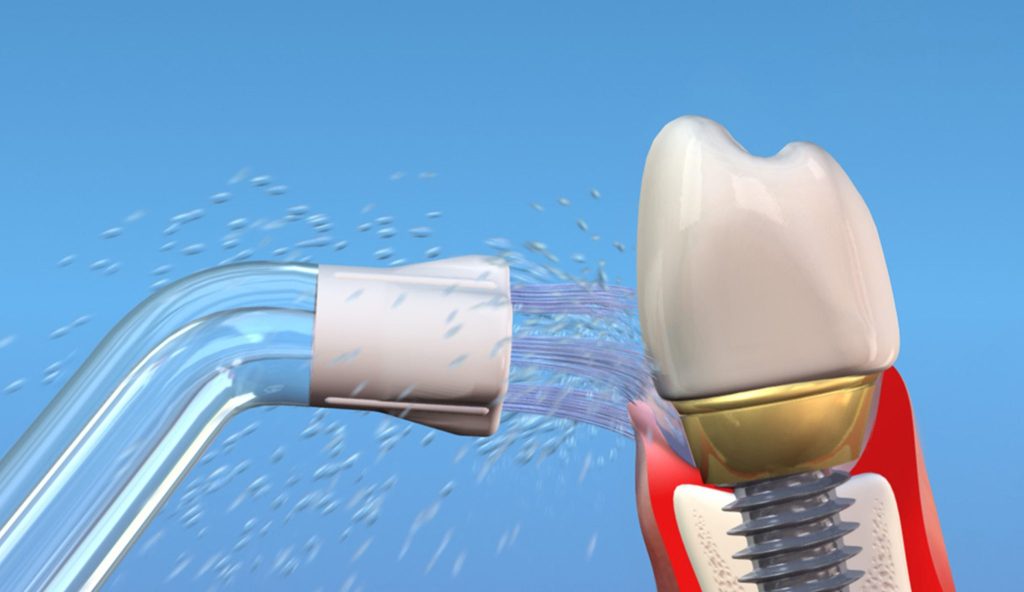Protecting patients’ investments
Featured Products Promotional FeaturesPosted by: Dental Design 28th January 2023

Dental implants are exemplary of the advancements made within the dental industry, regarding both the techniques and skillsets of dental professionals. The materials used in the fabrication of dental implants have also vastly improved over the years. This modality helps dental professionals restore a patient’s confidence and oral function, providing long-lasting comfort and use. However, many patients may not realise that while these treatments offer striking aesthetics, they must be protected in the same way as natural dentition in order to facilitate their longevity.
This treatment is an investment, and all patients must be aware of how they can best care for their dental implants in-between regular dental appointments.
Biofilm? Sticky business
Diseases that impact the tissues around a dental implant, such as peri-implant mucositis and peri-implantitis, are a burden to the patient and to the professional, often threatening the outcome of the treatment while inflicting discomfort and pain.[i] For the health of the patient and success of their treatment, it’s imperative that patients are able to adequately care for their dental implants. As dental implant components provide an ideal environment for the adhesion of bacteria, poor oral hygiene can quickly lead to the potential for oral complications.
As you well know, the oral cavity is home to a rich microbial community – a delicate composition that can be easily disturbed by internal and external forces, leading to disease.[ii] For both natural and artificial surfaces, biofilm development is thought to occur in several stages: admission of pathogenic bacteria into the oral cavity; salivary pellicle formation (a protein-based coating that covers surfaces of the teeth); increase of biofilm-forming bacteria; the exchange of drug-resistant genes between pathogenic biofilms and normal oral microflora; and, finally, the maturation of the biofilm.[iii]
Nesting bacteria is a common concern when it comes to dental implant placement. As previously mentioned, the components of a dental implant provide a favourable nook for bacteria to nest and thrive, although many advanced solutions on the dental market have been designed to reduce this risk. Product modifications have enhanced the relationship between the dental implant surface and the surrounding hard tissue, encouraging osseointegration while ensuring that the risk of biofilm formation remains low.[iv]
Patient compliance
 There have been numerous studies that correlate the outcome of dental implant therapy with the level of patient compliance.[v] [vi] Additional risks of peri-implant issues include patients who are diabetic, smoke, have a history of periodontal disease and take certain medications.[vii] [viii] In order for patients to best protect their dental implants and keep the risks of peri-implant diseases at a minimum, they must adhere to a strict oral hygiene routine. From the treatment planning stages right up to the regular, post-operative dental check-ups, there are plenty of opportunities for the dental team to advise and guide patients.
There have been numerous studies that correlate the outcome of dental implant therapy with the level of patient compliance.[v] [vi] Additional risks of peri-implant issues include patients who are diabetic, smoke, have a history of periodontal disease and take certain medications.[vii] [viii] In order for patients to best protect their dental implants and keep the risks of peri-implant diseases at a minimum, they must adhere to a strict oral hygiene routine. From the treatment planning stages right up to the regular, post-operative dental check-ups, there are plenty of opportunities for the dental team to advise and guide patients.
As you know, brushing twice-daily with a fluoride toothpaste is considered the gold standard in oral hygiene maintenance, in addition to interdentally cleaning once a day. Interdental cleaning is perhaps the most neglected aspect of most patients’ oral hygiene routines, with one study showing that 68% of adults don’t floss.[ix] Many dentists and dental hygienists have heard the same tale – that interdental cleaning is uncomfortable, or even painful for patients. There are numerous methods of interdental maintenance, however, and the efficacy of each one depends upon the patient’s dexterity and the size/shape of their interdental spaces.[x] In light of this, dental professionals should be recommending a range of interdental cleaning methods, tailored to the patient and their individual needs – this can include traditional floss, interdental brushes or a water flosser.
Water flossers were developed in 1962,[xi] and have become a popular choice for interdental cleaning. They have been proven to be more effective than string floss in removing plaque and, [xii] due to their design, they can be comfortable to hold and manoeuvre when in use. Waterpik® is proud to be the world’s number 1 water flosser brand and has developed a range of models to suit varying patient preferences. This solution is ideal for those with dental implants, crowns, bridges and veneers, helping patients remove bacteria from deep between the teeth and below the gumline. In fact, the Waterpik® Water Flosser is more than 2 times as effective as string floss for cleaning around dental implants.[xiii] Easy-to-use and needed for only a minute a day, the Waterpik® Water Flosser can enrich patients’ oral hygiene routines at home.
Give patients what they need for good oral health
The removal of biofilm is pivotal in the prevention of oral diseases, and to reduce the risk of dental implant failure. Arming patients with tried and trusted solutions can help them to better care for their oral health at home, so they can enjoy the benefits that their dental implants offer for longer.

For more information on Waterpik® Water Flosser products visit www.waterpik.co.uk. Waterpik® products are available from Amazon, Costco UK, Argos, Boots, Superdrug and Tesco online and in stores across the UK and Ireland.
Join the 3,000+ dental teams who have already benefitted from a professional Waterpik® Lunch & Learn. Book your free session for 1 hour of verifiable CPD and a free Waterpik® Water Flosser – available either face to face or as a webinar – at www.waterpik.co.uk/professional/lunch-learn/
Author:
Sharon Kidd – GDC – 4566Diploma in Dental Hygiene 1993Hygienist
Sharon qualified as a dental nurse in The Royal London Dental Hospital in 1988. She trained as a dental hygienist in the Royal Army Dental Corps in 1993.
Sharon has experience working as a hygienist in a variety of different settings including dental hospital, domiciliary home visits, military, private and general practice. She works with specialists and general dental practitioners to support patients with different needs including those who are nervous to visit the dentist.
Sharon is also a professional educator for Waterpik.
[i] Ghensi, P., Manghi, P., Zolfo, M., Armanini, F., Pasolli, E., Bolzan, M., Bertelle, A., Dell’Acqua, F., Dellasega, E., Waldner, R., Tessarolo, F., Tomasi, C. and Segata, N. (2020). Strong oral plaque microbiome signatures for dental implant diseases identified by strain-resolution metagenomics. npj Biofilms and Microbiomes, [online] 6(1), pp.1–12. Available at: https://www.nature.com/articles/s41522-020-00155-7#Sec11 [Accessed 3 Oct. 2022].
[ii] Marsh, P., Do and Devine (2013). Oral biofilms: molecular analysis, challenges, and future prospects in dental diagnostics. Clinical, Cosmetic and Investigational Dentistry, [online] p.11. Available at: https://www.ncbi.nlm.nih.gov/pmc/articles/PMC3652372/#:~:text=Oral%20biofilms%20are%20functionally%20and,provide%20benefits%20to%20the%20host. [Accessed 3 Oct. 2022].
[iii] Rath, S., Bal, S.C.B. and Dubey, D. (2021). Oral Biofilm: Development Mechanism, Multidrug Resistance, and Their Effective Management with Novel Techniques. Rambam Maimonides Medical Journal, [online] 12(1), p.e0004. Available at: https://www.ncbi.nlm.nih.gov/pmc/articles/PMC7835112/#b5-rmmj-12-1-e0004 [Accessed 3 Oct. 2022].
[iv] Kligman, S., Ren, Z., Chung, C.-H., Perillo, M.A., Chang, Y.-C., Koo, H., Zheng, Z. and Li, C. (2021). The Impact of Dental Implant Surface Modifications on Osseointegration and Biofilm Formation. Journal of Clinical Medicine, [online] 10(8). Available at: https://www.ncbi.nlm.nih.gov/pmc/articles/PMC8070594/ [Accessed 3 Oct. 2022].
[v] Cortellini, S., Favril, C., De Nutte, M., Teughels, W. and Quirynen, M. (2019). Patient compliance as a risk factor for the outcome of implant treatment. Periodontology 2000, [online] 81(1), pp.209–225. Available at: https://onlinelibrary.wiley.com/doi/abs/10.1111/prd.12293 [Accessed 3 Oct. 2022].
[vi] Do, T.A., Le, H.S., Shen, Y.-W., Huang, H.-L. and Fuh, L.-J. (2020). Risk Factors related to Late Failure of Dental Implant—A Systematic Review of Recent Studies. International Journal of Environmental Research and Public Health, [online] 17(11), p.3931. Available at: https://www.mdpi.com/1660-4601/17/11/3931/htm [Accessed 3 Oct. 2022].
[vii] Meyle, J., Casado, P., Fourmousis, I., Kumar, P., Quirynen, M. and Salvi, G.E. (2019). General genetic and acquired risk factors, and prevalence of peri‐implant diseases – Consensus report of working group 1. International Dental Journal, [online] 69(S2), pp.3–6. Available at: https://onlinelibrary.wiley.com/doi/full/10.1111/idj.12489 [Accessed 3 Oct. 2022].
[viii] Daubert, D.M., Weinstein, B.F., Bordin, S., Leroux, B.G. and Flemmig, T.F. (2015). Prevalence and Predictive Factors for Peri-Implant Disease and Implant Failure: A Cross-Sectional Analysis. Journal of Periodontology, [online] 86(3), pp.337–347. Available at: https://aap.onlinelibrary.wiley.com/doi/abs/10.1902/jop.2014.140438 [Accessed 3 Oct. 2022].
[ix] yougov.co.uk. (n.d.). YouGov. [online] Available at: https://yougov.co.uk/topics/politics/articles-reports/2017/10/23/three-ten-brits-only-brush-their-teeth-once-day [Accessed 4 Oct. 2022].
[x] Luz, M., Guarizo Klingbeil, M.F., Gomes Henriques, P.S. and Lewgoy, H.R. (2016). Comparison between Interdental Brush and Dental Floss for Controlling Interproximal Biofilm in Teeth and Implants. Dental Health: Current Research, [online] 2(3). doi:10.4172/2470-0886.1000119.
[xi] Lyle, D.M. (2012). Relevance of the water flosser: 50 years of data. Compendium of Continuing Education in Dentistry (Jamesburg, N.J.: 1995), [online] 33(4), pp.278–280, 282. Available at: https://pubmed.ncbi.nlm.nih.gov/22536661/ [Accessed 3 Oct. 2022].
[xii] Goyal, C.R., Lyle, D.M., Qaqish, J.G. and Schuller, R. (2013). Evaluation of the plaque removal efficacy of a water flosser compared to string floss in adults after a single use. The Journal of clinical dentistry, [online] 24(2), pp.37–42. Available at: https://europepmc.org/article/med/24282867 [Accessed 3 Oct. 2022].
[xiii] Magnuson B, Harsono M, Stark PC, et al. Compend of Contin Ed in Dent 2013; 34(Special Issue 8):2-7. Study conducted at Tufts University, School of Dental Medicine, Boston, Massachusetts.








